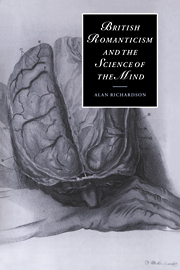Book contents
- Frontmatter
- Contents
- List of illustrations
- Preface
- List of abbreviations
- 1 Introduction: neural Romanticism
- 2 Coleridge and the new unconscious
- 3 A beating mind: Wordsworth's poetics and the “science of feelings”
- 4 Of heartache and head injury: minds, brains, and the subject of Persuasion
- 5 Keats and the glories of the brain
- 6 Embodied universalism, Romantic discourse, and the anthropological imagination
- 7 Epilogue
- Notes
- Bibliography
- Index
- CAMBRIDGE STUDIES IN ROMANTICISM
5 - Keats and the glories of the brain
Published online by Cambridge University Press: 22 September 2009
- Frontmatter
- Contents
- List of illustrations
- Preface
- List of abbreviations
- 1 Introduction: neural Romanticism
- 2 Coleridge and the new unconscious
- 3 A beating mind: Wordsworth's poetics and the “science of feelings”
- 4 Of heartache and head injury: minds, brains, and the subject of Persuasion
- 5 Keats and the glories of the brain
- 6 Embodied universalism, Romantic discourse, and the anthropological imagination
- 7 Epilogue
- Notes
- Bibliography
- Index
- CAMBRIDGE STUDIES IN ROMANTICISM
Summary
On July 12, 1821, Charles Bell read the first of a brilliant series of lectures, “On the Nerves,” to the Royal Society, with Humphry Davy (now a respectable baronet) in the President's chair. The lectures, published soon after in the Philosophical Transactions, summed up Bell's work to date, with special attention to the facial nerves and their network of connections, via the brain and spinal cord, to the respiratory and circulatory systems – the cornerstone of his thinking on how facial expression, speech, breathing, the heart, and the “emotions and passions of the mind” all functioned holistically through the medium of the brain and nerves (112: 285–6). They also bore witness, Bell announced, to the “new character” that the nervous system had assumed through the “gradually accumulating” discoveries of the metropolitan “schools,” thanks to which its “intricacies” had been “unravelled, and the peculiar structure and function of the individual nerves ascertained,” replacing the “absolute confusion” of the past with the revelation of its “natural and simple order” (111: 398). Now “even the youngest students” of the London medical schools learn enough about the newly revealed nervous system to understand its basic workings and to “decypher and to read” its hermetic “language” (111: 400).
- Type
- Chapter
- Information
- British Romanticism and the Science of the Mind , pp. 114 - 150Publisher: Cambridge University PressPrint publication year: 2001



